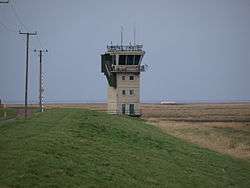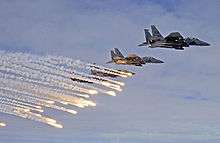RAF Holbeach
RAF Holbeach also Air Weapons Range Holbeach,[1][2] is a United Kingdom Ministry of Defence academic air weapons range (AWR) situated between Boston and King's Lynn near Gedney Drove End on The Wash, in Lincolnshire, eastern England. Most of the range, including the control tower and four observation towers (Quads) are in Gedney, but it does overlap with Holbeach to the west. On UK Civil Aviation Authority issued aeronautical charts the military Danger Area is found marked and identified by the code WRDA D207/II[3] or the ICAO code EG D207 (Weapons Range Danger Area or United Kingdom Danger, 207), the danger altitude is usually up to twenty-three thousand feet AMSL.
| RAF Holbeach / Air Weapons Range Holbeach | |
|---|---|
Royal Air Force Holbeach | |
| Near Gedney Drove End, Sutton Bridge, Long Sutton and Holbeach in England | |
 RAF Holbeach Bombing Range Control Tower | |
 RAF Holbeach Location of RAF Holbeach Bombing Range within Lincolnshire | |
| Coordinates | 52°51′17.42″N 0°10′14.71″E |
| Type | Bombing range |
| Area | 3,875 hectares (3,875 ha; 14.96 sq mi) |
| Site information | |
| Owner | Ministry of Defence (United Kingdom) |
| Operator | Defence Infrastructure Organisation East |
| Controlled by | |
| Open to the public | Yes (Public footpath only) |
| Site history | |
| Built | 1926 |
| Built by | The En-Tout-Cas Co. (Syston) Ltd., (Aviation Dept.) of Leicester |
| In use | 1926–present |
| Garrison information | |
| Current commander | Squadron Leader (retired) Christa Lawrence, range Training Safety Officer (TSO) |
| Occupants | RAF ATC (TG9) and contracted civilian staff from Landmarc Solutions |
| Airfield information | |
| Identifiers | ICAO: EGYH |
| Elevation | 5 metres (16 ft) AMSL |
History
The range opened in 1926 as an air gunnery range attached to and established by Royal Air Force Practice Camp Sutton Bridge (later named RAF Sutton Bridge).[4][5][6] Use of the range began on 27 September 1926, with biplanes firing and dropping bombs over the area formally known as "Holbeach Air Gunnery and Bombing Range",[6] and colloquially simply as Holbeach Marsh Range.[5]
During the late 1950s, when RAF Sutton Bridge was placed on a Care and Maintenance role, the coastal marshland air gunnery range was renamed to RAF Holbeach Bombing Range and it became later parented to RAF Marham as an Air Weapons Range (AWR) within RAF Strike Command. On 1 April 2006 control was transferred to the Ministry of Defence—Defence Training Estate East (DTE East), located at West Tofts Camp in West Tofts near Thetford in Norfolk; now renamed Defence Infrastructure Organisation East (DIO East).[1]
DIO are responsible for operational support—building, maintaining and servicing the infrastructure, the RAF are responsible for safe practice on the Range. The Range is administered at a local level by the DIO Training Safety Officer (TSO), who has an office at the Range. RAF air traffic control personnel staff the Range Control Tower supported by civilian range staff outsourced to Landmarc Solutions.
Emblem
The station's badge features a vertical sword through a crown. The motto is Defend and Strike.
Facilities
Extending over an area of 3,875 hectares, which includes 3,100 hectares of intertidal mudflats and 775 hectares of salt marsh,[1] the air weapons range provides facilities for RAF and NATO-allied aircraft to practice dropping bombs and firing their aircraft weapons, including pre-deployment training.[2] Since 1993 this has included night bombing and helicopter operations.[1] The range facilities are not only used by air force squadrons stationed in the United Kingdom but also fly over directly from airbases located throughout Europe. An assortment of range targets, 8 in total,[1] include several retired merchant ships which have been beached on the sands of The Wash for this purpose. Observation towers parallel to the target line are manned and allow the fall of aircraft ordnance to be calculated for accuracy by means of triangulation. The range includes a helicopter landing pad near the main control tower and since 2010 a new range headquarters building.[2]
At the present time aircraft types such as the Tornado GR4, Eurofighter Typhoon, F-35B Lightning II (No. 617 Squadron RAF), USAF F-15 Eagle/F-15E Strike Eagle (from 48th Fighter Wing), Hawk Trainer[7] and AgustaWestland Apache AH1 helicopters can be seen operating on the range at various times of the day, including on occasions CV-22B Osprey (from 7th Special Operations Squadron), HH-60G Pave Hawk (from 56th Rescue Squadron), Chinook, Merlin and Puma HC helicopters.[1][8] The range also hosts frequent Forward Air Control (FAC) or Joint Terminal Attack Controller (JTAC) exercises.
Strafing

RAF Holbeach also has facilities for scoring strafing runs. The strafing targets are a number of three-metre square net with an orange bullseye made by weaving plastic strips through the chicken-wire net. The Strafe Scoring detects the X-Y position of the projectile from the acoustic signature of the supersonic shock wave. This result is sent by radio to the control tower, where it is displayed to the Air Traffic Controller for relaying to the pilot. The range also has semi-automatic bomb and rocket scoring systems.
References
- Defence Training Estates East, Public Information Leaflet, Air Weapons Range RAF Holbeach.
- GOV.UK Announcement, Ministry of Defence, New HQ for Lincolnshire air weapons range.
- Map code as on aeronautical map issued by the UK Civil Aviation Authority, printed by Ordnance Survey, print date 1987.
- The official naming used and found in official Air Ministry notices, the London Gazette and other publications is "R.A.F. Practice Camp Sutton Bridge". One example publication: FLIGHT, 24 May 1928, Air Ministry Announcements, Page 394: The Royal Air Force, Royal Air Force Intelligence, Appointments, I.W.C. Mackenzie to "R.A.F. Practice Camp, Sutton Bridge", 14.4.28
- Airfield Focus 65: Sutton Bridge, Alastair Goodrum, 1997, ISBN 9781904514152
- GOV.UK Publications, Ministry of Defence: Holbeach Air Gunnery and Bombing Range Bylaws 1939.
- Video Footage: July 2013 - showing aircraft Tornado GR4 and Hawk Trainer aircraft practicing at RAF Holbeach Bombing Range.
- Video Footage: March 2013 - F-15Es, Apache & Tornado aircraft practicing over RAF Holbeach Bombing Range.
External links
- Video Footage: July 2013 - Tornado GR4 and Hawk Trainer aircraft practicing at RAF Holbeach Bombing Range.
- Video Footage: March 2013 - F-15Es, Apache and Tornado aircraft practicing over RAF Holbeach Bombing Range.
- Video Footage: August 2011 - showing A-10C Thunderbolts practicing at RAF Holbeach Bombing Range.
- Video Footage: August 1991 - showing aircraft SEPECAT Jaguar, Belgium Air Fforce Mirage, A-10 Thunderbolt, Tornado and F-111 Aardvark practicing at RAF Holbeach Bombing Range.
- "Royal Air Force Station Holbeach". on-target-aviation.com. 2008. Retrieved 18 April 2010.
- BBC News England: RAF Tornado crashes at Holbeach Bombing Range, 24 October 2006.
- BBC News England: RAF Tornado crashes at Holbeach Bombing Range, 26 October 2006.
- Thunder & Lightnings - aviation enthusiasts, including airfield viewing guides
- Queen Elizabeth enjoyed detonating an unexploded dummy bomb at RAF Holbeach on 4 February 2008
